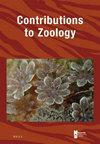从形态学和分子遗传学数据推断出海洋相关螨(Acari, Oribatida, Ameronothroidea)的系统发育
IF 2.2
2区 生物学
Q1 ZOOLOGY
引用次数: 1
摘要
海洋相关奥里巴斯螨主要属于Ameronothroidea,在所有奥里巴斯亚目中所占比例很小。在过去的几十年里,人们对该类群的系统学和进化史进行了有争议的讨论,但在几个问题上仍然没有达成共识。极端的海洋环境可能导致了平行形态,使基于离散形态特征的系统发育分类和估计变得复杂。在本研究中,我们使用线粒体和两个核标记进行了分子遗传学研究,以推断该群体的系统发育。此外,我们使用不同的算法,根据形态学数据重建了无齿龙的系统发育。这两种方法都产生了很大程度上一致的拓扑结构,并强调了以下要点:Ameronothroidea代表了一个副系集合;足螨科是一个独特的科,应被排除在无尾虫科之外;Fortuynidae、Selenoribatidae和Tegeoranellidae构成一个单系谱系;某些Selenoribatidae属需要修订。这些结果表明,Ameronothroidea的分类和该组中的某些位置需要彻底重新考虑和修订。本研究还表明,基于编码形态学数据的系统发育估计可以成为验证和支持分子系统发育的一个非常有用的工具。本文章由计算机程序翻译,如有差异,请以英文原文为准。
One step closer but still far from solving the puzzle – The phylogeny of marine associated mites (Acari, Oribatida, Ameronothroidea) inferred from morphological and molecular genetic data
Marine associated oribatid mites belong mainly to the Ameronothroidea which represent a very small percentage of all Oribatida. Over the last decades the systematics and evolutionary history of this group has been discussed controversially and still there is no consensus concerning several issues. The extreme marine environment may have resulted in parallel morphologies complicating the classification and estimation of phylogeny based on discrete morphological traits. In the present study, we performed a molecular genetic study using a mitochondrial and two nuclear markers to infer the phylogeny of this group. Additionally, we reconstructed the phylogeny of Ameronothroidea based on morphological data using different algorithms. Both methods resulted in largely congruent topologies and highlight the following important points: the Ameronothroidea represent a paraphyletic assemblage; the Podacaridae are a distinct family and should be excluded from Ameronothridae; the Fortuyniidae, Selenoribatidae and Tegeocranellidae constitute a monophyletic lineage; and certain genera of Selenoribatidae need a revision. These results demonstrate that the classification of Ameronothroidea and certain positions within this group need to be thoroughly reconsidered and revised. The present study also shows that phylogenetic estimates based on coded morphological data can be a very helpful tool for verifying and supporting molecular phylogenies.
求助全文
通过发布文献求助,成功后即可免费获取论文全文。
去求助
来源期刊

Contributions to Zoology
生物-动物学
CiteScore
4.00
自引率
4.50%
发文量
16
审稿时长
>12 weeks
期刊介绍:
Contributions to Zoology solicits high-quality papers in all systematics-related branches of comparative zoology (including paleozoology). Preference will be given to manuscripts dealing with conceptual issues and to integrative papers (e.g., ecology and biodiversity, morphology and phylogeny and character state evolution, phylogeny and historical biogeography, systematics and bioinformatics, bioinformatics and biodiversity, habitat disturbance and biogeography, etc.). Reviews and alpha-taxonomic contributions are considered for publication, but acceptance will depend on their high quality and exceptional nature.
 求助内容:
求助内容: 应助结果提醒方式:
应助结果提醒方式:


